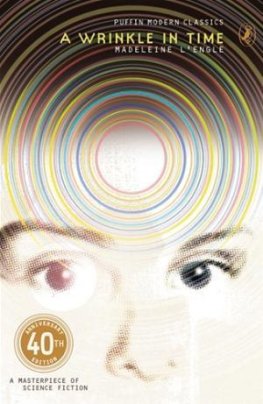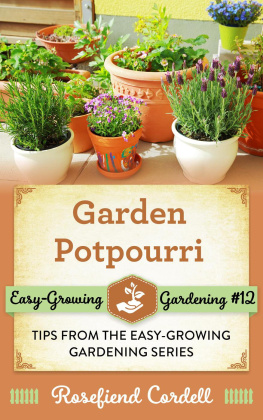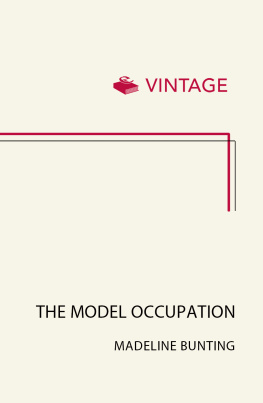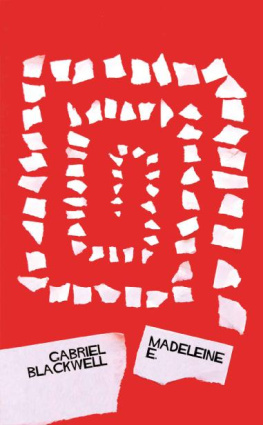Madeleine H. Siegler - Making potpourri
Here you can read online Madeleine H. Siegler - Making potpourri full text of the book (entire story) in english for free. Download pdf and epub, get meaning, cover and reviews about this ebook. year: 1991, publisher: Storey Publishing, LLC, genre: Home and family. Description of the work, (preface) as well as reviews are available. Best literature library LitArk.com created for fans of good reading and offers a wide selection of genres:
Romance novel
Science fiction
Adventure
Detective
Science
History
Home and family
Prose
Art
Politics
Computer
Non-fiction
Religion
Business
Children
Humor
Choose a favorite category and find really read worthwhile books. Enjoy immersion in the world of imagination, feel the emotions of the characters or learn something new for yourself, make an fascinating discovery.

- Book:Making potpourri
- Author:
- Publisher:Storey Publishing, LLC
- Genre:
- Year:1991
- Rating:5 / 5
- Favourites:Add to favourites
- Your mark:
- 100
- 1
- 2
- 3
- 4
- 5
Making potpourri: summary, description and annotation
We offer to read an annotation, description, summary or preface (depends on what the author of the book "Making potpourri" wrote himself). If you haven't found the necessary information about the book — write in the comments, we will try to find it.
Making potpourri — read online for free the complete book (whole text) full work
Below is the text of the book, divided by pages. System saving the place of the last page read, allows you to conveniently read the book "Making potpourri" online for free, without having to search again every time where you left off. Put a bookmark, and you can go to the page where you finished reading at any time.
Font size:
Interval:
Bookmark:
by Madeleine H. Siegler
Fragrance has the power to arouse forgotten emotions and events. It activates the brain in a unique way. It can stimulate and exhilarate, or it can dull the senses. Animals respond to it much as humans do. A sleeping cat is very much awake when a bag of catnip is opened; the dog snoozing on porch steps is suddenly alert when the scent of cat is in the air. The nose remembers even when the body rests.
In my years spent working with fragrance I have seen this memory function at work many times. Weary travelers stopping to visit the herb gardens would suddenly look years younger when a certain aromatic plant took them back to their childhood. Customers in the shop would beg for more of a certain potpourri when some element in the fragrance recalled a long-forgotten happy memory.
One dictionary defines potpourri as a combination of various incongruous elements; and also as a mixture of dried flower petals and spices kept in a jar and used to scent the air. The phrase pot pourri comes from the French. The literal translation is rotten pot. The moist method of making potpourri from fresh rose petals does result in a rotting process of sorts.
The art of blending potpourri incorporates these two definitions. Some of the recipe ingredients may appear incongruous; combine them all and they play their part in creating fragrance. Basically you will be using dried petals and spices, mixing them with necessary fixatives and oils to create a lasting and pleasing aroma with which to enhance your surroundings.
A really fine potpourri has one predominant aroma and many subordinate ones. Expensive perfumes are blends of as many as 150 fragrances; one of my best potpourris contains 20. As with soup making, the more you put in, the richer the result.
Learning to capture the scent of roses and lavender, recognizing such exotics as frankincense and myrrh, vetiver and tonka bean, and knowing how to blend them all together is creatively rewarding and can add a fresh dimension to life.
If you maintain gardens you have a source of fragrant and colorful materials to dry and use; a sentimental bouquet can bloom forever in your jars of potpourri.
Any record of the first potpourri is lost in history. We do know that fragrance has long been important to man. As early as 2000 B.C., precious spices and resins such as myrrh and frankincense were carried over trade routes between Egypt and India, Greece and China, to supply a demanding market. Herodotus, the historian, records many of these early trade routes and describes the wonders of a shipment of cloves or ambergris arriving in Greece.
The first uses of fragrance were for incense to burn in the temples. Then the aristocracy discovered the pleasure of sweet odors in their homes. Early baths were actually great clouds of scented steam enveloping the body. A servant using a smooth tool would then scrape the body, to remove dead cells and dirt. A cooling bath followed in water perfumed with lemon and later with roses.
A method of extracting the highly fragrant oil from roses was discovered by accident. Tradition says that in India a young princess was about to marry. To prepare the way, the canals on which the bridal barge would float had been sprinkled with fresh rose petals, much as we scatter them for todays bride. This lovely princess trailed her hands over the side of the barge and found her fingers delightfully fragrant with the thin film of rose oil on them. Thus began the search for the best method of extracting the fragrance from the rose.
The Toilet of Flora, possibly the first instruction book on the art of making potpourri, was printed in London in 1779. It contains many recipes for cosmetics, tooth powders, hair restorers, and sweet bags. These bags were worn on the body or placed in chairs and bedding to release their pleasant odors. The author used cloves and cinnamon, orris root and benzoin, rose petals and lavender ingredients you will find in my recipes.
Other formulas for sweet-smelling mixtures were written down in the housewifes stillroom book, along with her recipes for cough syrup, flea repellent, and worm medicine. These classic potpourri recipes all result in fragrances that are rose, lavender, floral, or oriental (heavy with musk and patchouli).
New mixtures called potpourri that contain wood chips and stiff strawflowers have appeared in recent years. Their aromas are overwhelmingly strong when first opened, yet quickly evaporate. Other currently popular potpourris are based on fruit and berry fragrances; eventually we may decide these are best left in the ice cream parlor or bakery.
Potpourri must have one or more elements from each of the following fine categories to have a lasting fragrance.
Roses Mint Lemon balm Lavender | Scented geraniums Marjoram Rosemary Lemon verbena | Thyme Bay leaves Costmary Sweet woodruff |
Allspice Anise Nutmeg Mace | Cloves Star anise Coriander Cinnamon | Cardamom Lemon peel Orange peel Vanilla bean |
Ambergris Jasmine Musk Rose Bergamot Lavender | Neroli Rose geranium Cinnamon Lemon Sweet orange | Sandalwood Clove Lime Bitter orange Ylang-ylang |
Orris root Benzoin Cellulose fiber | Calamus Tonka bean Vetiver | Myrrh Oakmoss Frankincense |
Pansies Calendulas Carnations Rose leaves Tulips Larkspur | Amaranth Ferns Daffodils Geraniums Asters | Nigella Salvias Delphinium Uva-ursi (bearberry) Feverfew |
Of all the flowers you may dry to use in potpourri, only roses and lavender will retain their aroma. All the leaves listed have scent glands not easily destroyed by drying; they keep their fragrance indefinitely.
The best roses for fragrance are the antique varieties. (Consult any good nursery catalog.) We enjoy gathering many petals from the sturdy rugosa roses so common here, but they cannot compare in aroma with my antique gallica and damask roses.
Lavender blossoms hold their perfume almost forever. They contain more oil for their weight than any other fragrant flower. All varieties of lavender are fragrant; my preference for potpourri is Lavandula vera.
Costmary (Chrysanthemum balsamita) is an old herb that holds its shape and minty smell for years. For potpourri use, press or air-dry the leaves.
Lemon verbena (Aloysia triphylla) has slender 3-inch leaves smelling more like a lemon than a lemon. Leaves do not crumble when stirred and shaken repeatedly. This plant is a tender perennial, equally at home in a large tub or in the garden.
Lemon balm (Melissa officinalis), an easily grown perennial herb, makes a fine cup of tea. It will yield its lemony smell long after it has been picked and dried. Caution: The leaves crumble easily, so handle carefully.
Font size:
Interval:
Bookmark:
Similar books «Making potpourri»
Look at similar books to Making potpourri. We have selected literature similar in name and meaning in the hope of providing readers with more options to find new, interesting, not yet read works.
Discussion, reviews of the book Making potpourri and just readers' own opinions. Leave your comments, write what you think about the work, its meaning or the main characters. Specify what exactly you liked and what you didn't like, and why you think so.








